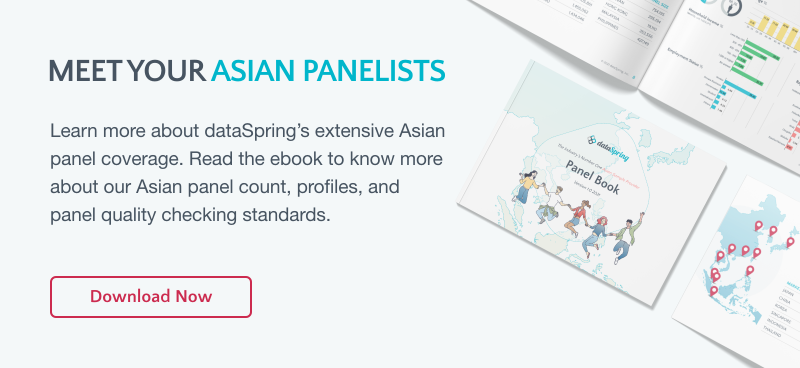
Introduction
dataSpring's Japan research panels are some of the best in Asia and include panelists from multiple sources - including proprietary online research panels through our surveyon platform, panelists integrated through our API called surveyon Partners and panelists recruited through our parent company's platform called ann-kate. We know the Japan market better than anyone and this article shares our tips for successfully conducting online research in Japan.
Languages
- Official: Japanese
- Survey: Japanese
Regions
Japan can be divided into nine categories below:
- Hokkaido/Tohoku
- Kanto
- Koshinetsu
- Hokuriku
- Tokai
- Kinki
- Chugoku
- Shikoku
- Kyushu/Okinawa
Areas that are often targeted by researchers are one or both of the following categories:
1. The capital city, Tokyo, the largest city in Japan, and the commuting areas around Tokyo:
- Tokyo
- Saitama
- Chiba
- Kanagawa
Note: Tokyo, Saitama, Chiba, and Kanagawa account for 36.3% of the total population.
2. The second largest city, Osaka, and the commuting area around Osaka:
- Osaka
- Kyoto
- Hyogo
- Nara
Demographics and Ratio of Panel Composition
The internet penetration rate is high at 93.3%* (as of 2018), and there is no big difference between population composition ratio and panel composition ratio. Our parent company, Marketing Applications Inc., offers Japanese panels and operates mobile applications for surveys. Due to high demand, we have focused our recruiting and retention efforts on the teens and 20s demographic groups, leading us to have a higher count of younger panelists than other companies.
| % | est. pop.1 | Ratio of Panel Composition for dS panel |
| Male | 48.63% | 46.62% |
| Female | 51.37% | 53.38% |
| 13-19yo | 4.41% | 8.57% |
| 20-29yo | 10.14% | 16.60% |
| 30-39yo | 10.76% | 16.18% |
| 40-49yo | 13.93% | 19.08% |
| 50-59yo | 14.01% | 21.32% |
| 60yo+ | 34.96% | 18.25% |
1Reference website: https://www.stat.go.jp/english/data/handbook/index.html
Income
In Japan, the concept of SEC is not very common. Therefore, when conducting online research, we often target individual monthly income or household monthly income.
*SEC is the socioeconomic characteristic that a consumer has - defined by variables such as income, educational background, occupation and so on. It stands for Social Economic Characteristics.
% Monthly Household Income
| Ratio of Panel Composition for dS panel | |
| Less than JPY 299,999 | 25.38% |
| JPY 300,000-499,999 | 17.61% |
| JPY 500,000 - 699,999 | 9.89% |
| JPY 700,000 - 999,999 | 7.48% |
| JPY 1,000,000 or higher | 8.09% |
| No Answer | 31.55% |
Local Pro Tip:
When conducting research in Japan, it is more common to ask people about their annual income rather than their monthly income. Because of this, respondents are also more accustomed to answering with their annual incomes. For that reason, it is better to ask about a respondent's annual income.
Ethnic composition
98.5% of the total population are regarded as Japanese ethnic. Knowing this, it is very difficult to specify targeting conditions and allocations based on the ethnic composition in Japan.
Precautions in Conducting Online Research
- We cannot ask questions that are against public order and morals. Please contact our sales representative in advance for any questions you are unsure of before conducting your research.
- Contents that are against the law
- Contents that are related to bullying and discrimination
- Contents that are related to anything sexual in nature
Final Words
Japan offers a lot of opportunities, especially now that the 2020 Summer Olympics will be held in Tokyo. With many businesses striving to enter its market every year leading up the games, it’s no surprise that Japan has become one of dataSpring’s most in-demand panels.
Before conducting online or mobile surveys in Japan, it’s important to know its basic profile. For more in-depth information, talk to our Local Experts today!
Online research panels have become one of the most important tools of the modern market researcher, and it can yield valuable insights and results if used properly. To know more about online research panels, especially in the Asian region, check out our Understanding Online Research Panels page.


 Download Panel Book
Download Panel Book


